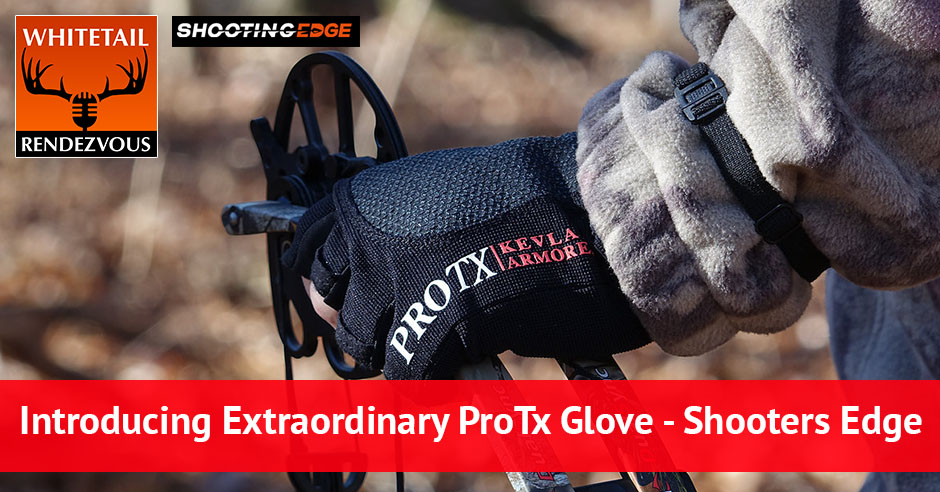
Shooting Edge’s mission is to provide technically advanced shooting products for the sportsman and shooter. They put special care in developing products that are made by, made for, and field tested by sportsmen. They provide the passion and customer service of a family-owned and operated business led by a revolutionary veteran in the hunting industry, Anthony Carlston. Anthony joins us to talk about their latest extra insurance for your next shooting experience, the ProTx Hand Guard.
—
Listen to the podcast here:
Introducing Extraordinary ProTx Glove – Shooters Edge
Thank you, Bruce, for giving me this opportunity to come on the show. My name is Anthony Carlston. I’m with Shooting Edge. We’ve been in the industry as Shooting Edge for a few years. The Founder of our company is my dad, Marvin Carlston. If you’re familiar with the archery industry, you’ve probably heard of Marvin by means of Gold Tip. He was the Owner and Founder of Gold Tip arrows and the men responsible for bringing us the modern carbon arrow as we know it. He’s been in the industry since ‘87. As a mechanical engineer, Marvin found an extreme need to protect our customers not from products that were defective but from accidents. Bruce, have you ever seen those injuries that you see on Facebook where somebody gets an arrow in the hand? Have you come across those?
I’ve seen more rifle or shotgun injuries, but I have seen some people that have impaled themselves in various parts of their body with their bows.
We’ve had rare accidents where somebody gets hit in the upper part of the body, chest or the face. The most common injuries that we see that Marvin and I were most concerned about were injuries that directly resulted in an impact of the arrow into the back of the hand. As an engineer myself, I served as a Quality Control Manager at Gold Tip from 2003 to 2009. When my dad and I retired from Gold Tip, I worked there in the manufacturing side of Gold Tip for multiple years before then. I was intimate in the process of how arrows were built and the quality side of them. We found that we couldn’t build a better product with the technology that’s available. That’s still the same story nowadays. There’s not a better way to address the issue because the product is amazing. You can’t get a better arrow out there as you could drive a nice Mercedes-Benz and still have an accident. You got to wear your safety equipment.
If you’re driving a vehicle like that and you don’t have a seat belt on, you’re going to get hurt. That’s what we’ve seen. As somebody that loves the sport, somebody that’s been raised in archery since I was five, I’ve been shooting a bow for many years now. I’ve found that you’ve got to do everything you can to not only shoot better but protect yourself from accidents. Archery is safe. We’ve got less than a 3% chance of an overall injury. As we discovered these injuries, we came across the government website where they tracked injuries that people get into the emergency room. They result in about 1,100 emergency room visits a year in the United States. That’s when Marvin and I said, “We got to do something.” We wanted to introduce you guys to the ProTx Hand Guard. It’s fingerless because if you’re like me, you like to fill the riser of your bow as you’re shooting, have control of the arrows and everything as well. The benefits of a lightweight shooting glove I love are the accuracy side. The safety of the three layers of Kevlar on the back of the hand is a bonus.
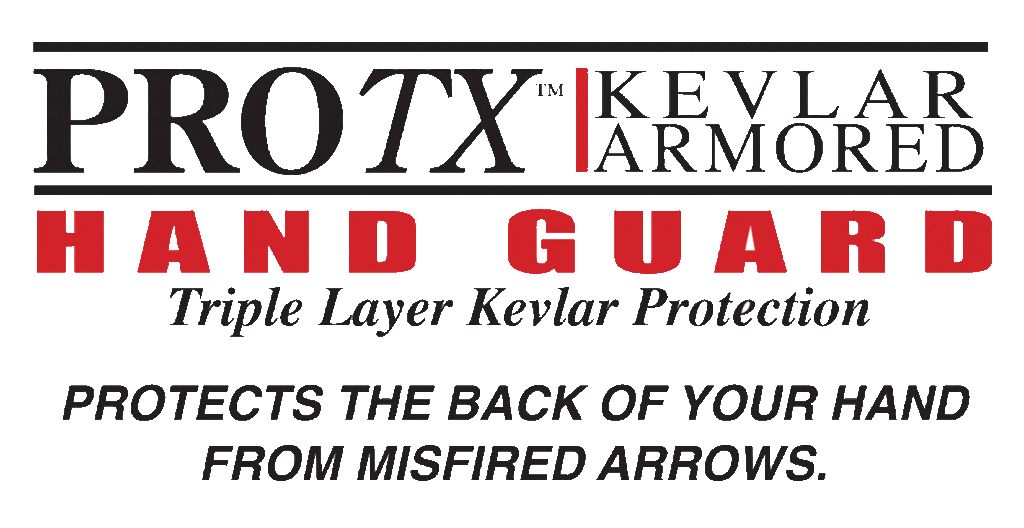
I’m giving you a little bit of history. I was being trained to shoot professionally. My goal at the time was to join the US Archery Team and participate on that level. My coach and I were shooting on the range at Gold Tip and he kept telling me, “Anthony, you’re torquing the bow.” I’m like, “How am I torquing the bow?” I’m shooting the best I was shooting. He’s like, “You’re torquing the bow. Your left and right movement on the target was not quite perfect yet. You need to wear a glove.” This particular gentleman, a lot of us probably have seen him wear a glove when he’s been out shooting professionally. He introduced me to a glove. He and I are polar opposites in size. He’s about 6’8”. He gave me his extra-large glove to wear. He’s like, “Put the glove on.” I’m like, “How’s that going to help?” I put it on. It was a blue polyester glove that you wear when you’re snowmobiling or underneath the glove liner.
I put it on and instantly I noticed my left and right movement on the target improved and the torque was nearly gone depending on how I held the bow at that point. That palm and that glove are smooth. It’s thin. You don’t want it too smooth because you don’t want your bow to come out, but you need to have thin material there so it doesn’t bolt. You don’t need a big winter glove. That’s what we did is we designed it off of that so we can have that consistent contact when we shoot. A lot of guys have a perception issue when you pick up a glove. Is it going to work? What are your thoughts on the glove at this point from what you’ve seen?
I like it because it fits. It reminds me a lot of my Fox gloves that I use on my mountain bike. The Kevlar, I shoot a crossbow, I don’t shoot a compound but when I lay that down if it’s going to be close to the ground, it’s going to be a barrier. I’m not worried about the crossbow of an arrow coming back at me. It could happen, but I’m not worried about that. It’s comfortable.
One of the benefits it has too, you’ve probably seen doctors subscribe people a wrist-supporting device. If you hurt your wrist, you go gather them at Walgreens or from a chiropractor or a sports therapist doctor. The material on the palm is a nylon polyester material. It’s the same material you’d find on those supportive gloves. It massages your hand as you wear it. It helps to reduce fatigue. One of the concerns archers had, and I’ve experienced this a lot over the years, is when I shoot, my hand would get fatigued and it’d start to get red. It could get bruised. I didn’t get a lot of bruising, it’d get sore.
The reason it gets sore is that your hand is trying to guide that bow into the natural position center of your hand. In the bow hunt, it slides on that muscle and it gets a little sore. The glove prevents that soreness and it can relieve it if it has occurred. It protects your hands when you’re out in the woods. We don’t have a matching glove for the right hand yet, but you can wear another shooting glove or a glove on that hand. A lot of guys prefer to have the right hand open if you’re shooting with a release bow, that’s why we haven’t covered the right hand yet at this point. We’re focusing on the left hand.
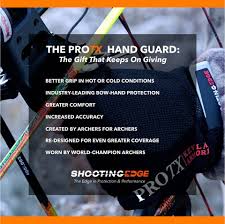 Let’s talk a little bit about some of the stories. You guys are probably wondering how does this benefit shooters? Have you heard of a gal by the name of Joella Bates? She’s an Olympic coach now. She’s been shooting archery her entire life. She has experimented with different levels of equipment. She shoots a barebow. She shot compound over the last several years with us. The last few years she’s been shooting specifically barebow. We’ve had her on staff for nine years. She’s won five world titles with the glove, three with the compound bow and two with her barebow. The neat thing about her journey, she’s in her 50s. In 2007, she qualified for the US Archery Team. As you can imagine, at that level in her life, that was a huge accomplishment. She attributes her success not only to her style of shooting but her ability to perform has increased because of the accuracy of the improvements of the glove.
Let’s talk a little bit about some of the stories. You guys are probably wondering how does this benefit shooters? Have you heard of a gal by the name of Joella Bates? She’s an Olympic coach now. She’s been shooting archery her entire life. She has experimented with different levels of equipment. She shoots a barebow. She shot compound over the last several years with us. The last few years she’s been shooting specifically barebow. We’ve had her on staff for nine years. She’s won five world titles with the glove, three with the compound bow and two with her barebow. The neat thing about her journey, she’s in her 50s. In 2007, she qualified for the US Archery Team. As you can imagine, at that level in her life, that was a huge accomplishment. She attributes her success not only to her style of shooting but her ability to perform has increased because of the accuracy of the improvements of the glove.
I’ll share a quote with you. You’ll find this quote on our website as well. She says, “The incredible thing I found this summer is that when it was hot and I was sweating, the glove allowed my hand to stay in perfect position and the handle of my recurve bow. I took my CD bow, the CD archery riser and ProTx glove and repeatedly won tournament after tournament, including two World Championships. When everybody else is hot and sweaty and complaining about how nasty it feels outside, I’m wearing a glove and they’re looking at me like I’m crazy. I was crazy in love with the results. It improves my accuracy and that is a real bonus.”
Accuracy is key. If you want to shoot more accurately especially in the summer when they’re sweating, you need to put on a ProTx Hand Guard. It keeps your hand perfectly placed in the riser shot after shot. You’ve probably experienced this throughout your life. Your palms might be sweaty if you’re nervous. As you’re working, your palms get sweaty. When you’re shooting a bow, your hand’s going to have a different feel on the bow each time and it’s going to affect how you shoot. What we’ve found is that the glove provides consistent contact regardless of whether you’re in the middle part of the day or first thing in the morning when it’s cooler. Your hand is going to control that moisture on your hand with the glove. It’s going to keep that consistent contact so you get that sweet spot shot after shot.
How do people get to your website?
It’s ShootingEdge.com. There’ll be more stories of Joella’s success and we’ve got a bunch of videos of her talking about the benefits of the product down there that get us in line into exactly how she’s found that this improves the accuracy.
I get the target hunting. What’s the crossover to people in the field that are hunting?
As a bow hunter, that’s where I invest my time. That’s where I’ve had the most success over the years. Target archery is fun, but I love to get behind my bow and go bow hunting. As a bow hunter, a lot of us don’t have a lot of time to invest in shooting well. Our goal is to make an ethical perfect shot each time. When we harvest an animal, we want to make sure we do it quickly. We want to make sure we have the best shot placement. I found that with my glove on, and if I haven’t had a lot of time to practice right before, I’m going to continue to shoot accurately because the glove gives me that much more of an edge when I’m out in the field. You’re going to encounter rain. You’re going to encounter snow. You’re going to encounter different conditions where if you’ve got a bare hand, it’s going to be either really dry which means your bow is going to not be in the right spot or it could be sweaty and moist. The glove helps control all of that.
The goal is to make an ethical perfect shot each time. Share on XAs a bow hunter, you want to have the easiest way to make the most accurate shot possible as you are out in the field, depending on what you’re going after. I do a lot of hunting out here in Utah and I’m going to some remote areas of the country. I gave the glove to a gentleman by the name of Jim Shockey. His first response was, “You just gave me a Michael Jackson glove.” He looked at it and he’s like, “That glove makes sense,” because in the areas where he and I hunt, if an accident happens, a simple injury to the hand may not be life-threatening in the city. Where you get down to the emergency room and get some help. If something happens in the areas where Jim and I hunt, that could be life-threatening. Some of the areas I’m three, four hours away from the emergency room and medical attention. If there was an accident, that could end it.

There’s nothing worse than pulling back on a big animal and your arrow breaks and you miss it. If the arrow breaks and you get it in your hand, you’re in far worse condition. That’s why we’ve got the benefits of the accuracy and then the protection on the back. As a bow hunter, you’ve got many things that could go wrong. You could fall on your equipment. As you were traveling through the woods or to your tree stand, you had an accident. Whatever happened you pull back and there was an issue with the arrow before you shot it. We’ll go through some inspection processes. Bruce, have you talked a lot about how to inspect arrows before when you’ve shot your equipment?
Tech Wednesday is coming up. This is apropos to what we’re doing. Why don’t you talk about how to figure out? I had a friend who was in Africa. When she let the arrow go, she heard an explosion. That was caused simply because the arrow was fractured. It was an invisible fracture. At release, all those physics at work and it blew the arrow up and that was that.
A lot of issues I’m sure if we were to inspect that. As an engineer, I’ll have that arrow sent to Marvin. We would find multiple things that could have happened. It could have been impacted prior to the shot. Meaning that in travel, maybe it got bumped up against something and it got hit. Maybe as she was shooting it, it got hit by another arrow and she bounced it off a rock. Something impacted it. When she shot, the paradox of the bow causes it to bend and that’s what came apart. Most cases though, we find that the issues of an arrow after the customer has inspected it, if they break at that point, it’s because an issue happened with the nocking point, meaning the nock serving is worn out. It’s too loose. They didn’t seek the nock.
Maybe you have a double click on your nock when you go to nock the string? Your nock should click twice and be firmly attached to the string. Maybe it wasn’t fully attached and when she pulled back, you’re pulling back on an animal so a lot of things can go wrong there. You’re not focusing, you’re excited. You got buck fever going on. That affects your ability to think anyways. Maybe when she pulled back, she didn’t have the nock seated all the way. When she shot, the string falls, the arrow falls off the string. It’s going to reengage the string three or four inches below the nocking point. That’s going to send your arrow right into the back of the riser, a perfectly good arrow.
We’ve seen that happen time after time. I remember the first couple of cases down at Gold Tip when a customer would send in their bow. We got a bow that came into the shop and all the pins were knocked out of the sight window. All the pins broke out. Marvin and I looked at it and go, “How on earth did they break off the pins out of their sight window?” You can imagine if you get an arrow through your hand because this customer had that happen. They had an arrow through their hand. They dropped their bow and we thought maybe when they dropped the bow, it broke the pins in the sight. There were no impact marks representing an impact from a fall from the bow being dropped. There was a tiny little impact mark on the inside of the sight window. We had a theory that maybe the arrow somehow had gotten caught and went through the sight window in midflight. It wasn’t until we were working with a gentleman by the name of Wade Nolan doing some broadhead testing that we caught an arrow break in slow motion. The arrow reengaged the string.
We had it on a Hooter Shooter. The arrow reengaged the string three or four inches down and the front part of the arrow went through the site window and broke out the pins and had broken that area. Had we had a hand there, the arrow would have impacted where a person’s hand would have been. If you go to our YouTube videos, you’ll see some similar videos of where other people have caught arrows break in slow motion by accident where it’s buckling and going towards the hand. A lot of times, it’s because of the nocking point. If you don’t inspect an arrow prior to your shot, if you get on our website, we’ve got some good inspection videos. Gold Tip has a good inspection video that they put together that they talk about the360 bend test. You have to bend test the arrow, bend it multiple times in multiple directions. You’re going to listen for sounds, look for fractures. Some people will carry a cloth with them or a cotton ball and run it across the shaft and see if you can get the fibers off your cotton ball that catch onto the broken part of the shaft.
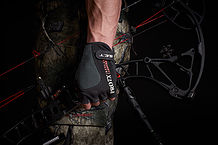 Sometimes you’re going to see an invisible fracture in the arrow that may not be visible until you shoot it. Sometimes with the small thing like a cotton ball or cloth, you can catch those edges and expose a fracture that way as well. That’s what I do in the field too. I carry a little cloth or cotton ball and try to capture that. Always inspect your arrows. Make sure your nock is not loose. Have you seen your arrows where they get cracks on the back of the nock? Not on the nock itself, but right on the shaft. That right there is one that we need to look at and make sure the nocking point doesn’t have any cracks on the nock or where it goes into the shaft. Make sure the ears of the nock aren’t bent. A lot of times we get customers to call us up and go, “My arrow broke,” and then they come and tell us, “My arrow fell out of the truck.”
Sometimes you’re going to see an invisible fracture in the arrow that may not be visible until you shoot it. Sometimes with the small thing like a cotton ball or cloth, you can catch those edges and expose a fracture that way as well. That’s what I do in the field too. I carry a little cloth or cotton ball and try to capture that. Always inspect your arrows. Make sure your nock is not loose. Have you seen your arrows where they get cracks on the back of the nock? Not on the nock itself, but right on the shaft. That right there is one that we need to look at and make sure the nocking point doesn’t have any cracks on the nock or where it goes into the shaft. Make sure the ears of the nock aren’t bent. A lot of times we get customers to call us up and go, “My arrow broke,” and then they come and tell us, “My arrow fell out of the truck.”
I’ll tell you a story of a gentleman. We had a guy out here that runs a successful archery shop. He had drawn a limited entry bull elk tag. He had gotten into his area, opened up the door of his truck and his bow fell out. He had his quiver attached to his bow and the arrows hit the ground. The nocks were slightly bent so he re-straightened them and went on his way. As he’s working that honey, called in his bull elk. He pulls back on the bull elk, pulled the trigger and dynamite went off. He’s sitting there going, “I’m a professional. I do this for a living. What happened?” Thankfully, the arrow missed his hand, it went downrange. He missed an animal of a lifetime. He’s thinking about it going, “I re-straightened my nocks. My nocks were broken.” I always tell customers never reshoot a knock that’s been damaged from another arrow or bent. If it’s bent, throw it away. Get rid of it. Put a new nock on.
Never reshoot a knock that's been damaged from another arrow or bent. Share on XAnthony has a special for you if you’re reading the blog from Whitetail Rendezvous Gear Tech. If you want to purchase their glove, what’s your special for anybody reading the blog?
The suggested retail price is $44.95. You’ll see them listed on the website for $39.95. For participating in the show, we’ll go ahead and give you that glove at $35.
Does that include shipping?
That’d be $35 plus shipping. In the continental US, it’s about $3 to ship.
Mention that you read Anthony’s talk about the ProTx glove. You’re going to get a discount. Go ahead and buy the glove because safety is critically important. I’ve got a friend that’s going to come up with a story about his climber and what happened to him. He lived, but it was sketchy. In archery, we gain habits, we climb, we set up, we shoot, we don’t think about what happens. Every year, 1,100 people go to the emergency room, which still is a lot of people that have accidents in regard to arrows.
When you come in and you’re in the emergency room and you’ve got an arrow in your hand, they’re going to document that as an injury to the hand. Maybe you’ve got a cut from a vein or you sliver in your hand, which also results into those numbers as well. The glove will prevent all those things from happening. That’s why we encourage it. I’ve got one story that has been quite close to me. Most of our audience will be hunting whitetails from a tree stand. We’ve got a guy coming on where he’s going to share his story of falling out of a tree stand. I met this guy briefly. When I met him, he was twenty, 23, 24 years old and from Ohio. He had shot a whitetail buck out of his tree stand. The arrow passed halfway through. He went and retrieved his arrow. His arrow looked fine. He cleaned the blood off of it. Put it back in his quiver. A couple of weeks later, he had shot another whitetail. He was up in his tree stand.
As he’s pulling back, he pulled the trigger. Every story I hear, it always sounded like dynamite. The arrow exploded. The impact of the arrow hit the back of his hand and the force of that impact threw him from the tree stand. Thankfully, he was wearing a safety harness, so he didn’t hit the ground, but he was in a climber. He had to pull himself back up on his platform with one hand to call for help. If you’re in a safety harness, you got about seven minutes or so before you start to lose severe circulation to your legs. You have to get up on the platform or on the ladder and back to the ground. That was the worst case scenario that we’ve had. Thankfully, he didn’t hit the ground, but that could have ended in somebody’s life at that point. He later realized that the arrow was broken. He was never aware of how to inspect an arrow.
One of the things we’re encouraging folks to do, you can go to our website called BowSafe.com. On there, you’ll find instructions on how to inspect arrows and why we should be wearing our safety harnesses, our arm guards and our hand guards. All those things are designed to keep us in the field longer. There’s nothing worse than having somebody get hurt, end up in a wheelchair. If somebody get hurt with an arrow on their hand, it’s not a life-threatening injury by any means. When I do training with folks, I’ll go around and I’ll shake hands with as many people in that training as I can. I’ll pay attention to the hands I shake and then I’ll ask that person, “Can you come forward for a moment? I noticed something with your hand.” What I’m looking for when I shake people’s hands that are archers is the feeling of the graphite sliver or carbon sliver working their way slowly out of your hand.
There's nothing worse than having somebody get hurt. Share on XWhy would that be the case? Graphite is not X-ray-able. If you’ve got large graphite slivers in your hand from an arrow, the doctor either has to do one of two things. Leave it in there or perform exploratory surgery to get it out because they don’t know where it’s at. They’re going to gather what they can see and then the rest they’re either going to leave in or with your permission basically dig through your hand to get as much of that out as they can. I’ve seen guys three, four years later with slivers still working their way out of their hand. That’s going to be coming out of the palm of your hand or your back, which makes it hard to shoot at that point. The worst part that you experience with is the PTSD of, “Is this going to be the next time this injury occurs?”
You and I do a lot of gun shooting. The first thing that we were always required to do when we’re shooting on a range is wear our hearing protection and eye protection. What we’re trying to encourage customers to do is get in the habit. Wear a ProTx Hand Guard every time you shoot and wear your arm guard. If you’re in a tree stand, wear a safety harness. Do those three things and then understand our equipment. You shoot a crossbow. Understand the limitations of the crossbow. When you’re shooting your bow, understand the limitations of your bow. Make sure you know how to inspect your bow and make sure you know how to inspect your arrows so that you don’t have an accident.
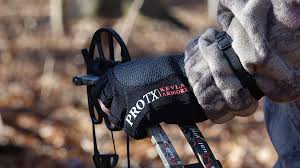
I’ve had incidences with crossbows. I got seven staples right on the top of my head with the crossbow. I’ve been shooting crossbows for years as well. My story with the crossbow is I was cocking it like I’ve done hundreds of times off of a gun rest which isn’t recommended, but it’s never failed me. I was recovering from Lyme disease so I was weaker than normal. As I was pulling it back, I almost had to the power curve, but I had to put my foot up on my bench I was sitting on. It changed the angle and the stock of the crossbow come out and the scope got me in the back of the head, right in the butt of the hat. That’s the only time I’ve ever had a bleeding injury from any archery equipment. I’ve hit my arm multiple times over the years. I wear an arm guard. I correct it, but I always wear an arm guard because even a bruise on the hand could be ending your day.
I had the 3D Pop-Up Tour the first time I’ve ever seen blood occur on an archery range. We had a gentleman probably in his 60s, he’s been shooting longer than I’ve been alive. He had a nock break on his arrow and he got hit right in his arm and the nock went into his arm, about a half-an-inch. I was there as a range officer. Usually, when you get an arrow, the arrow comes out the palm of your hand. I looked at it and went, “That’s a clean hole.” I’m looking for the arrow going, “The arrow’s not in his hand, thankfully.” When we found the arrow, the nock was broken off right at the back of the arrow. The nock and the string had hit his arms. He had the string bruise from the string slap and then he had a hole in his hand from the nock.
This is a guy that hadn’t worn an arm guard in many years. Had he been wearing an arm guard at that event, he would have never been embarrassed in front of a crowd that was waiting for Ted Nugent. This was at the Hunt Expo in Salt Lake City when this happened. They had bleachers set up to watch this event. He had bruised himself in front, caused that injury in front of that crowd. He had that happen as well. I’ve seen them happen personally. I’ve had it happen to myself. Everybody’s subject to the same thing. Our advice is to try to protect yourself. Have fun. Archery is safe. I’m not going to be the first one to say you shouldn’t participate because it’s not safe. Archery is the safest sport we can participate in.
If you’ve ever played football, the requirements are if you get on the field for football, you’re going to have to wear a helmet and pads and mouth guard. Hopefully, you’ve conditioned yourself. You’re in good physical shape to go play. That’s what we’re encouraging guys to do is practice as often as you can, get to know your equipment, and have fun. One of the things I love about telling people about the stories of the glove when I first developed the glove, I had some local shooter guys that weren’t having extreme success with their bows. They had bought the best equipment available at the time. I went back and forth with these guys multiple times, gentlemen by the name of Matt and Ben. I said, “I know you’re shooting well, but the reason you’re not getting on the podium in your events,” and these are amateur-type local events. I said, “The reason you’re not podium is that you still have some torque issues with the bow. You’ve worked out everything else. You got the best equipment. You’re practicing a lot.”
Both the guys have targets in their yards, big outdoor ranges where they can shoot well enough to practice. I said, “If you put a glove on, we can improve your score for your circuit about twenty to 30 points. The first time I give them the glove, both of them were shooting a 3D Pop-Up event where targets move on the machines. Had the tournament finished Saturday, they would have finished probably 6th and 9th. When they put the glove on, by the time they finish Sunday, one had finished first and the other had finished third for the first time ever shooting a blow. The only thing they had done differently was put a glove on.
You have to prove it to yourself and you can go to the Shooting Edge website and find videos and testimonials. If you decide to buy a glove, you get it for $35 by mentioning Whitetail Rendezvous. How do you want to wrap this up, Anthony?
One of the things we want to do and we’re going to do a 30/30 challenge that we’re going to introduce on our website. We’re going to challenge everybody to try the glove out. What we’re looking for is we want you to take 30 shots over probably a two or three-day period without the glove into Vegas-style three-spot target and document the results of shooting without the glove. Shoot through some paper tune without the glove and document those results. Take some pictures or a video of it and say, “Here’s my 30 shots in the three-spot target face. Here’s what my score would have been without the glove.”
We want to take and do the same thing with the glove over a three or four-day period and shooting 30 arrows in three different target faces on the same target and three different spots. Shoot through the paper test and then document those results. What we’re looking for is we want to see how much people are going to improve from the bare hand to the glove. We want to graph that and say, “If you’re an amateur guy from the age of twenty to 30 and you consider yourself an amateur archer based off of how many people we take the sample from, this is what you could expect to see your performance improve on,” so people feel confident moving into it.
I’ve gone back to Matt and Ben and I said, “Can you participate in this 30/30 Challenge with me?” They’re like, “Anthony, I can’t shoot without the glove.” Before they’re like, “I don’t want to shoot with the glove. It’s going to interfere with my shot.” Now they’re like, “I don’t want to not take the glove off and shoot.” They have to wear the glove to shoot now because of one, how comfortable it is and two, their performance. My dad and I are the same way. We won’t shoot without the glove because of the performance and safety is a bonus. It’s all about the performance. It’s all about shooting better and doing it simply.
One of the other things I learned when I was training, I spent a few weeks training our US Archery guys. I tried to get them to wear the glove on the Olympic archery courses. They came back to me and said, “Anthony, we can’t wear that glove or a glove in general because it will disqualify us.” I’m thinking, “That’s silly because it’s safety, but you’re going to shoot better.” They’re like, “That’s the point. We will shoot so well as Olympic archers that nobody will be able to compete with each other or I’ll be shooting the exact same if we wear a glove.”
That’s when I realized there is a point to the accuracy that the US Olympic Archery Teams have said, “We won’t allow a shooter to wear a shooting glove because they will shoot better than everybody else.” To keep everybody competitive, they’re not allowed to wear the gloves on that circuit. As bowhunters, we can look to that and go, “We need all the advantages we can get. Those guys have proven that this does shoot better. We’ve proven it here as professionals as well that it does shoot better.” That’s why we want to do that 30/30 Challenge to help you see that as well.
You can find that 30/30 Challenge on ShootingEdge.com. Sign up for that. Anthony, it’s been a joy having you on the 1st edition of 2019 Tech Wednesday. Thank you so much for being on the show.
Thank you, Bruce.
Important Links:
- www.ShootingEdge.com
- www.Air-Bolt.com
- www.BowSafe.com
- www.SaveOutdoorSports.com
- https://www.Youtube.com/User/ShootingEdgeTechcom
- https://www.Youtube.com/Channel/UCftZ3gKVqhVFWsphxQyHSLQ
- https://www.ShootingEdge.com/Protx-Videos
- Shooting Edge
- Gold Tip
- ProTx Hand Guard
- ShootingEdge.com
About ProTx
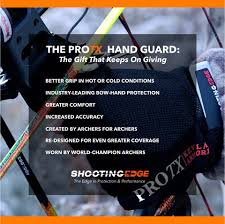 In today’s bow hunting marketplace there is an increased focus on the “liability” of equipment manufacturers, archery instructors, and guides/outfitters for injuries being sustained by archers. This is a simple, yet disconcerting fact about today’s world. We contend that any & every opportunity you have to LIMIT YOUR LIABILITY, and thus your exposure to lawsuits brought about by injury from the use of your product(s), is a good thing.
In today’s bow hunting marketplace there is an increased focus on the “liability” of equipment manufacturers, archery instructors, and guides/outfitters for injuries being sustained by archers. This is a simple, yet disconcerting fact about today’s world. We contend that any & every opportunity you have to LIMIT YOUR LIABILITY, and thus your exposure to lawsuits brought about by injury from the use of your product(s), is a good thing.
AND
If you are aware of a way or manner to protect your consumers and don’t do so, the phrase “failure to warn” could quite possibly become a very unwelcome part of your vocabulary. For example, just think of a boat manufacturer that doesn’t encourage the use of a PFV (personal floatation device). That boat manufacturer has just exponentially increased their liability…it’s no different with an archery-specific equipment manufacturer, instructor, or guide/outfitter. If they don’t suggest the use of specific safety equipment (eye, arm & BOW HAND) they, and their business could be at significant risk. Learn more about the S.E.T. ProTX glove. Don’t learn about “failure to warn” in the courtroom.
